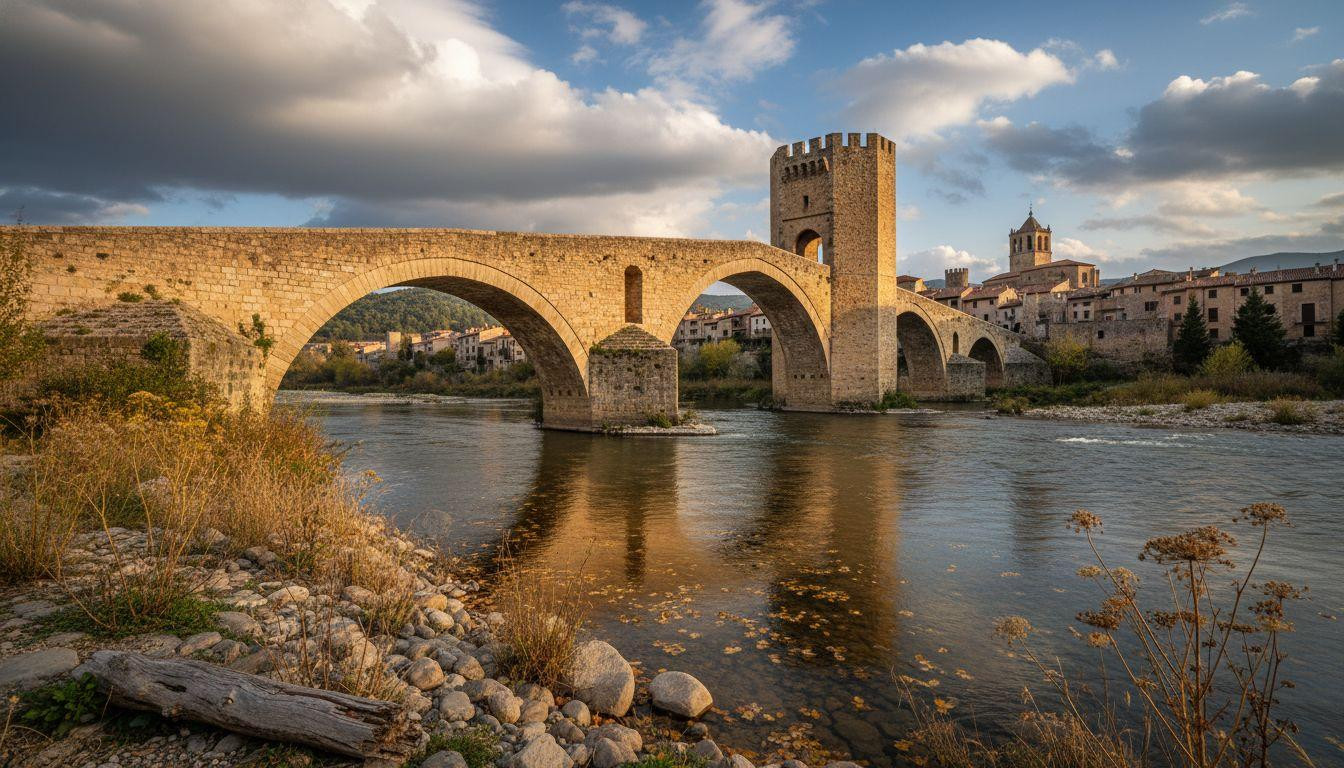Dawn breaks over the Fluvià River as golden November light catches seven Romanesque arches spanning 344 feet of honey-colored stone. Steam rises from coffee cups in 2,500 morning windows of a village where Barcelona’s crowds never reach. This is Besalú, where a 12th-century fortified bridge guards 900 years of Catalan history for $60-90/night instead of Barcelona’s $165-275. Two defensive towers frame the entrance to cobblestone streets worn smooth by eight centuries of footsteps. Here, a preserved Jewish mikveh whispers of medieval multicultural life, and Civil War scars forced reconstruction from historical texts rather than tourist imagination.
The Latin name “bisuldunum” means “fort between two rivers.” This geographic advantage shaped Besalú’s destiny from Roman settlements through its golden age as an independent county capital from 897 to 1300 AD.
Where two rivers meet 93 miles from Barcelona
Besalú perches in the Garrotxa region’s Pyrenean foothills, 1.5 hours north of Barcelona and 45 minutes from Girona. The approach reveals the fortified bridge first, rising from morning mist like a medieval gateway to another century. Parking sits outside the historic center where vehicle restrictions preserve authentic character.
Train tickets from Barcelona to nearby Girona average $17-27, with onward bus connections adding $6-11. Rental cars cost $33-66 daily for compact vehicles. The town’s modest 100,000-150,000 annual visitors create uncrowded exploration compared to Barcelona’s millions. Population remains steady at 2,000-2,500 residents, maintaining authentic local life within medieval architecture that rivals Portugal’s hilltop villages without overwhelming tourism.
The bridge that survived civil war destruction
The Pont de Besalú represents more than medieval engineering. This 344-foot span with seven unequal arches grouped in two angled sections showcases Romanesque mastery from 1130. Two fortified gateway towers once defended access and collected medieval tolls.
Romanesque engineering from 1130
The bridge’s distinctive angular bend provides strategic sightlines while accommodating the Fluvià River’s natural flow. Honey-colored limestone construction creates photogenic conditions during golden hour, approximately one hour before sunset. Multiple vantage points reward photographers: from the bridge looking upstream, from riverbank below, and from the town approach revealing towers against sky.
1939 damage and 1960s reconstruction
Spanish Civil War destruction demolished two arches in 1939, leaving the bridge severely damaged. Community commitment to historical accuracy guided careful reconstruction during the 1960s based on medieval texts and illustrations rather than imagination. This restoration demonstrates authentic preservation over commercialized tourism. The bridge crosses free of charge, unlike many ticketed heritage sites.
Today’s structure maintains medieval character while ensuring contemporary safety. Similar fortified architecture appears in Transylvania’s Saxon villages, though Besalú’s reconstruction story adds layers of 20th-century resilience.
Medieval streets where centuries pause
The entire town holds National Historic-Artistic Ensemble designation, reflecting exceptional architectural integrity. Narrow cobblestone streets follow medieval urban logic, creating intimate human scale through hidden courtyards and sudden plazas. Casa Comella represents Catalonia’s best-preserved Romanesque civil architecture.
Monastery of Sant Pere and religious heritage
Founded in 977 by Besalú’s counts, the Monastery of Sant Pere anchors the town’s spiritual heritage. The surviving church displays striking Romanesque basilica design featuring three naves and central apse with plant-motif decorations. The Church of Sant Vicenç (circa 977) serves as parish church with impressive rose window creating luminous interior effects during midday hours.
The Hospital of Sant Julià from the 12th century functioned as medieval traveler hostel. Though reconstructed, its facade conveys authentic hospitality traditions from Catalonia’s rich cultural heritage.
Jewish quarter preservation
The Placeta de los judíos preserves medieval synagogue remnants and an exceptionally well-preserved 12th-century mikveh. This ritual purification bath demonstrates sophisticated Jewish community presence during the High Middle Ages. Guided visits cost $6-9 with advance booking required. National Cultural Heritage protection acknowledges Besalú’s significance as multicultural medieval society.
Medieval documentation confirms the town’s role as major Jewish center before later persecutions dispersed the community. The mikveh remains Spain’s only surviving Romanesque example.
Autumn in catalan foothills
September through November provides optimal visiting conditions with temperatures ranging 54-68°F and post-summer crowd departures. The annual Medieval Fair transforms the town each September weekend with period costumes, artisan demonstrations, and historical reenactments. October delivers crisp mornings and clear photographic light perfect for capturing honey-stone warmth.
Catalan cuisine dominates local dining with escalivada roasted vegetables, botifarra sausage, and pa amb tomàquet bread with tomato. Many restaurants occupy converted medieval stone buildings, adding sensory richness to meals. Casual dining costs $11-17 per person, mid-range establishments $20-33, fine dining $39-55. This represents 40-50% savings compared to Barcelona pricing.
River trout from Fluvià tradition appears on contemporary menus. Villages defined by their rivers share this connection between waterways and local cuisine.
Your questions about Besalú answered
How much does Besalú cost compared to Barcelona?
Accommodations range $55-88 budget, $88-143 mid-range, $143-220 boutique properties often in restored medieval buildings versus Barcelona’s $165-275 for comparable quality. Dining costs $11-17 casual, $20-33 established restaurants collectively 40-60% less than Barcelona. Most attractions including bridge crossing, monastery, and streets require no entrance fees unlike ticketed heritage destinations.
What makes Besalú different from commercialized medieval towns?
Genuine 1960s reconstruction from historical texts after Civil War damage demonstrates authentic preservation over tourist fantasy. National Historic-Artistic designation enforces preservation standards while 2,000-2,500 residents maintain authentic local life. Modest visitor volume prevents overtourism. No modern commercial signage, chain restaurants, or tourist shops disrupt visual coherence extending back centuries.
When should I visit in 2025?
September-November ideal: September Medieval Fair weekend event with living history, 68°F temperatures, autumn colors. October offers best photography with clear skies and golden light. November provides maximum solitude though shorter daylight. Spring April-May presents secondary option with verdant landscapes and moderate crowds at 57-64°F.
As afternoon light catches the bridge’s fortified towers at 5:30 PM, the Fluvià River flows beneath seven arches that have witnessed 900 years of Catalan history. This isn’t Barcelona’s commercialized medieval quarter. This is authentic preservation with Civil War scars and scholarly dedication, waiting 93 miles north for travelers who value substance over staging.
